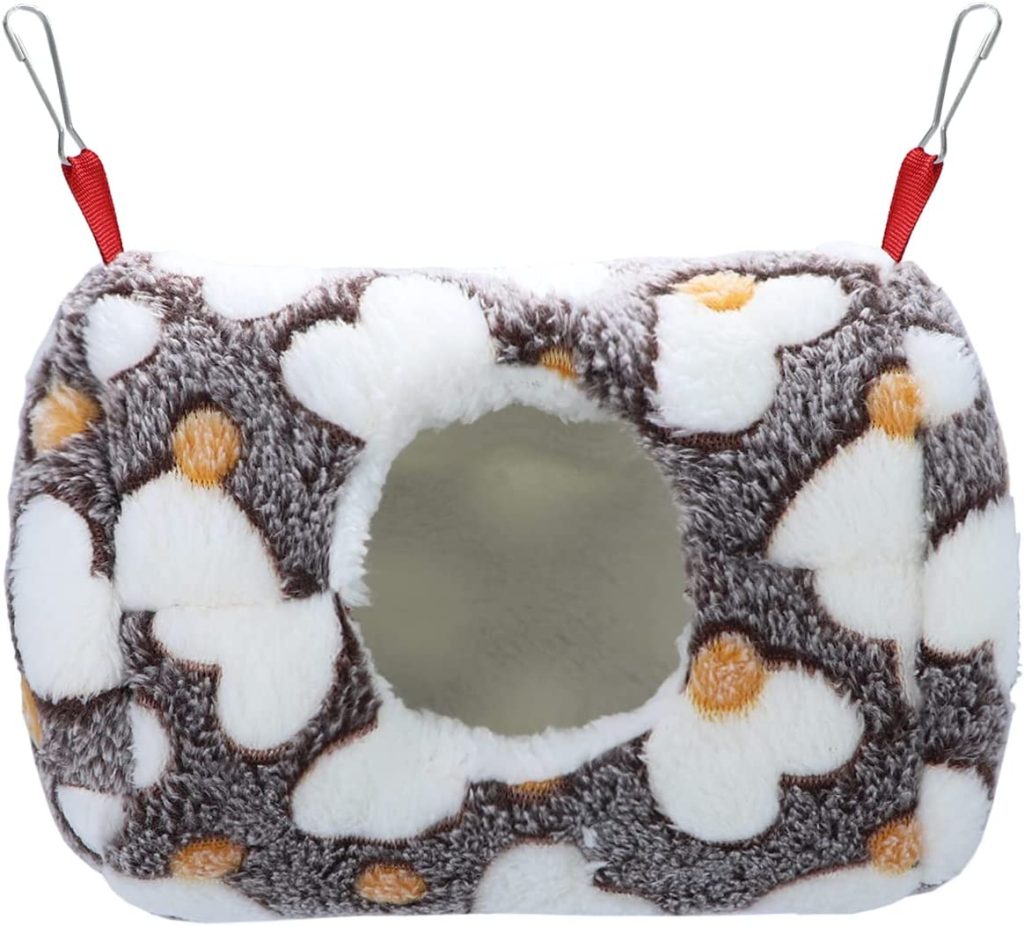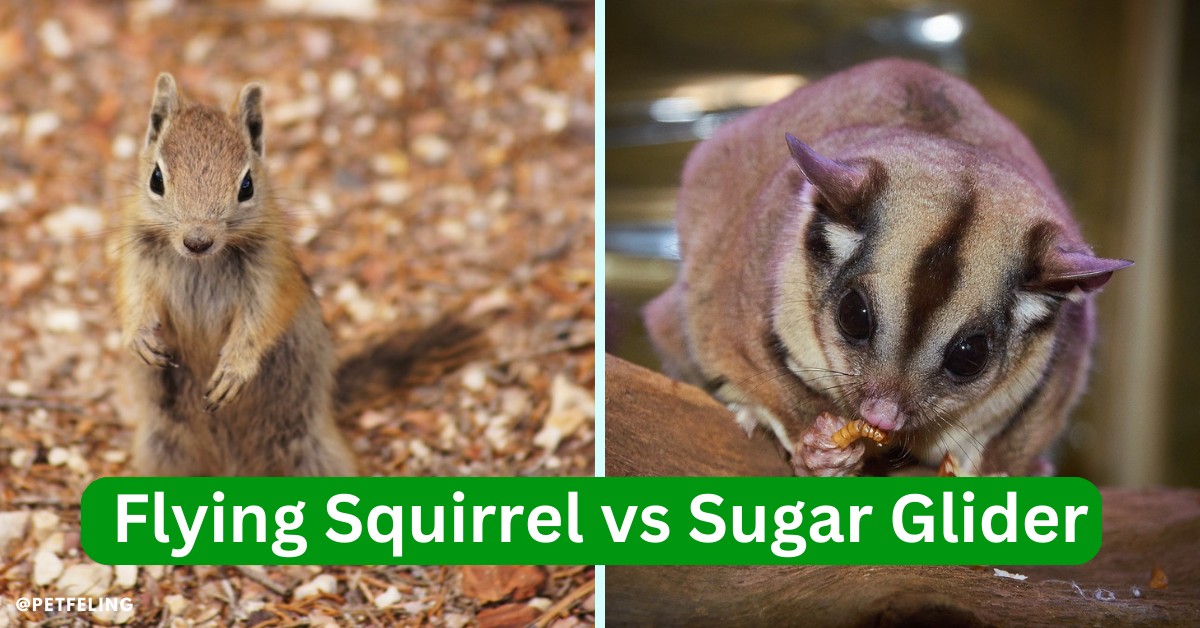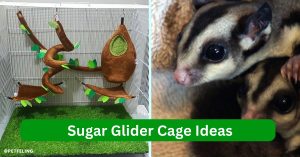Both flying squirrels and sugar gliders are adorable, tiny creatures that are well-liked as pets. Although flying squirrels, which are in the US, and sugar gliders have surprisingly similar appearances, the two species are very dissimilar. Let’s quickly examine the distinctions between these two species.
What is a Flying Squirrel?
Along with chipmunks, marmots, prairie dogs, flying squirrels, ground squirrels, and tree squirrels, flying squirrels are rodents. Northern Europe is home to the Siberian flying squirrel, whereas North America and Central America are. They have a lifespan of up to 5 years in captivity and an average of 2–3 years in the wild. Because of its outstanding gliding abilities, this species that climbs trees might be better known as a flying squirrel. Despite its name, the flying squirrel doesn’t actually fly like a bird.
What is a Sugar Glider?
A tiny mammal known as a sugar glider or sugar squirrel. They have a close relationship with kangaroos and koala bears.
Is a Sugar Glider a Squirrel?
Sugar gliders are not squirrels, though. A sugar glider is a little marsupial that is related to kangaroos and koala bears. Rodents include squirrels in their family.
The Similarities between a Flying Squirrel and a Sugar Glider
When compared to flying squirrels, sugar gliders have similar eyes, a patagium membrane, sleeping habits, and parental behavior.
Eyes
Their large eyes allow them to see and scavenge for food at night.
Patagium Membrane
The patagium membrane, a skin flap that extends from the front to the rear legs, is present in both animals. Stretched-out glider arms capture air as they fall, giving the glider stability and direction as it moves from tree to tree. The ability to glide helps gliders and flying squirrels avoid predators and find food.
Sleeping Pattern
Both types of animals are nocturnal, sleeping during the day and being more active at night. Due to their midnight antics, either might not make a good pet for a light sleeper.

Males Caring for their Offspring
Both the flying squirrel and the sugar glider’s male counterparts abstain from parenting their young.
Metabolic Bone Disease
Gliders and flying squirrels are prone to metabolic bone disease. This disease develops when the diet lacks calcium. If the illness is not treated with vitamins or a change in food, both animals will die.
Tails
Both Flying Squirrels and Sugar Gliders have long, bushy tails!
What’s the Difference Between a Flying Squirrel and a Sugar Glider?
There are a number of ways the flying squirrel and sugar glider are different. Raising their young, companionship needs, gliding distance, behavior, vocalizations, lifespan, body heat, smell glands, and native origins are among the distinctions. A placental mammal, or one in which the placenta grows in the uterus before birth, is a female flying squirrel. A marsupial mammal called a sugar glider spends very little time growing inside its mother. Following birth, the infant crawls inside the mother’s pouch, where it consumes her milk and develops.
Where Do Sugar Gliders and Flying Squirrels Come From?
When people talk about flying squirrels, they usually mention the Northern or Southern Flying Squirrels, which are native to America. In contrast, sugar gliders are indigenous to eastern and northern Australia, New Guinea, the Bismark Archipelago, and the United States. However, Asia is also home to a variety of other flying squirrel species. Some examples include the Japanese flying squirrel, Spotted Giant flying squirrel, Woolly Flying Squirrel, and Red Giant Flying Squirrel.
Are Sugar Gliders and Flying Squirrels Mammals?
The manner in which flying squirrels and sugar gliders reproduce is one of their main distinctions. Placental animals belonging to the Sciuridae family include flying squirrels. This implies that their offspring develop inside the mother’s uterus before birth. A unique embryonic organ that is connected to the uterine wall provides nutrition. The placenta is what gives mammals with placentas their name. These mammals endure lengthy gestations and deliver live young after the embryo has reached full maturity.
Sugar gliders are marsupial animals belonging to the Petauridae family, as opposed to flying squirrels. As a result, the sugar glider is connected to kangaroos rather than flying squirrels. Marsupials are pouch animals with very short gestation periods and live births. Newborns get nourished from their mother’s nipples until they are completely mature and dwell inside a pouch-like hole in the mother. Marsupial mammals have a placenta that resembles a yolk because they give birth so early. This yolk-shaped placenta is unable to sustain the fetus for an extended period of time.
Companions
A flying squirrel may live alone, but it also values having a friend. Flying squirrels can fly alone, but gliders require a partner to soar with. Gliders who are left alone are more likely to experience despair and may act aggressively. Gliders frequently over-groom, self-mutilate, or kill their tails when they are under stress, sad, disoriented, in pain, losing their appetite, not having a companion, or losing their companion. Another glider can provide camaraderie and friendship that humans cannot. Gliders groom, bond, and communicate with one another in ways that humans cannot match.
Gliding Distance
A sugar glider can travel up to 165 feet in the air. The fact that flying squirrels can glide anywhere between 150 and 500 feet is even more amazing! You will unquestionably be in awe of these two “flying beasts” because of their prowess in the air!
Behavior
Flying squirrels are more at ease and self-assured than sugar gliders, who exhibit greater personality swings and anxiety. If they are awakened and moved out of their cages throughout the day, sugar gliders are particularly vulnerable to stress.
Vocalizations
When frightened, irate, or worried, sugar gliders vocalize by repeatedly generating a screaming noise known as “crabbing.” Additionally, they bark nonstop when looking for other gliders. Flying squirrels chirp to communicate and are far less vocal than other species.
Sugar Glider Lifespan
Although their typical lifespan is more like 10 to 12 years, sugar gliders can survive up to 15 years in captivity.
Flying Squirrel Lifespan
The flying squirrel can live up to 20 years in captivity and 2 to 10 years in the wild.
Body Heat
Body heat is one difference between a flying squirrel and a sugar glider. Due to their sensitivity to cold, sugar gliders are susceptible to dying in such conditions. Gliders require a heat lamp in their habitat to maintain a temperature between 68 and 72 °F (20 and 22 °C), as they are adapted to warm, humid, and tropical conditions.
Scent Glands
Flying squirrels do not have smell glands, while sugar gliders do. A smell gland is located in the center of the top of the head of male sugar gliders. In the middle of the broad portion of the black stripe, the gland results in a bald area. A gland is also present in the middle of the breast in males. An anal smell gland is present in both men and women, whereas females have a scent gland in their pouches.
Physical Appearance: Sugar Glider vs. Flying Squirrel
The flying squirrel and the sugar glider may look identical at first glance, but closer inspection reveals several distinctions. The ability to glide or “fly” across trees is shared by both creatures thanks to a membrane that connects their rear legs to their front legs. But the female sugar glider also has a pouch for carrying the young, as was already explained. The female flying squirrel lacks this.
On their backs, sugar gliders have a dark gray stripe as well. In contrast, depending on the species, flying squirrels will have a range of different coats. They come in a range of sizes as well. The northern and southern flying squirrels are typical-sized mammals. There are also enormous flying squirrels, though. These have the same size as a domestic cat. The body length of the sugar glider, on the other hand, ranges from 120 to 320 mm. The large eyes of sugar gliders are one distinguishing feature between them and flying squirrels. They perfectly encapsulate cuteness!
Evolutionary Diversity In Sugar Gliders & Flying Squirrels
The world’s sugar gliders come in six different species. In contrast, there are 50 different species of flying squirrels worldwide. In this instance, the distinction between sugar gliders and flying squirrels is fairly stark. The diversity of flying squirrels in nature is not surprising, given how common they are. Flying squirrels and sugar gliders are also thought to be the offspring of convergent evolution. The progenitors of placental mammals and marsupial mammals were therefore likely members of the same family. However, towards the middle of the Jurassic period, the marsupial ancestors diverged from their placental relatives. Since then, these animals have separately evolved.
For more than 100 million years, marsupial mammals such as sugar gliders have also lived geographically apart from placental mammals. Over the course of evolution, marsupial mammals spread throughout Australia. The diversity of placental animals allowed them to colonize the majority of the planet. Flying squirrels and sugar gliders are considered to have evolved in a convergent fashion despite these geographical differences. This indicates that they have comparable habitats and lifestyles. They share a lot of physical characteristics as well. For instance, they both tend to be nocturnal. They will also live in trees because they are arboreal. In addition, they have big eyes that can gather light, allowing them to see in the dark. They are both omnivores that will consume both plant and animal matter.
Conclusion
The main differences between flying squirrels and sugar gliders are numerous. The way these two creatures breed and give birth to their young may be their most important distinction. You can distinguish between these two mammals based on their habitat and evolutionary variety.
FAQ Section
Are sugar gliders and flying squirrels the same thing?
Placental mammals include flying squirrels. Before giving birth, placental mammals spend a significant amount of time growing inside their mother’s body while receiving nutrition from the placenta. Like kangaroos, sugar gliders are marsupial mammals.
What else do you call a flying squirrel?
Volans glaucoma The southern flying squirrel (Glaucomys volans) and the northern flying squirrel are the two species of flying squirrels that can be found in Minnesota (Glaucomys sabrinus).
Can you have a pet flying squirrel?
Flying squirrels can make excellent pets, but they can also be difficult companions to have. If you desire one, look into sites that offer moral rehabilitation so you can save them. Make sure you have a lot of time for them and are prepared to build a close relationship.
Are flying squirrels aggressive creatures?
Flying squirrels are not a threat to human health or safety. They have keen fangs but are not aggressive. Call a registered and experienced wildlife professional from Summit Environmental Solutions if you notice flying squirrels caging out in your attic or wall voids.
Flying squirrels: are they safe?
Flying squirrels: are they dangerous? Although flying squirrels are not a threat to people, they are a threat to your property. When squirrels enter homes, they can gnaw through and harm insulation, walls, pipes, and cables. Flying squirrel damage may result in fire and water damage.



